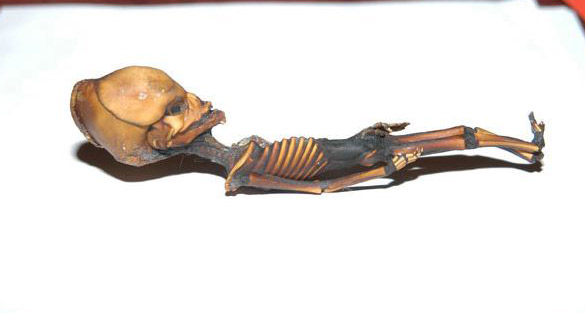
Analysis of the Atacama humanoid alien
We posted earlier this week a story outlining the origin of the alleged tiny ET creature to be showcased in Dr. Steven Greer’s Sirius documentary to be released later this month. We chronicled how this creature was none other than a case known in Chile as the La Noria ET
from 2003; the name comes from a ghost town of the nitrate era in this
part of Chile’s northern Atacama Desert region. We left the story sort
of in a cliff hanger as to what happened to it once it was acquired by a
Spanish businessman from Barcelona.
We’ve discovered since a number of things, including the original 7 minute TV program about the case aired by Chile’s Megavisión Channel V shortly after the creature’s discovery was published in the local press. You can now see this program on YouTube in Spanish, and it shows exactly the location where the creature was discovered, as well as interviews with Oscar Muñoz, the man who found it, Alejandro Dávalos, the first one to photograph the being, and well known Chilean ufologist Rodrigo Fuenzalida, director of the AION UFO research group.
It’s clear that this program was done in the early stages of the La Noria case, when the little being was owned by the pub owner from the provincial capital of Iquique. He didn’t appear in the program because he probably wanted money to allow filming the creature (that was his modus operandi according to the newspaper La Estrella de Arica) and the TV channel didn’t go along with it.
More importantly, we discovered who bought the creature and what happened once it left Chile and traveled to Spain, where it has remained ever since. It turns out that its owner is Ramón Navia-Osorio, a wealthy entrepreneur from Barcelona who runs the IIEE (Spanish acronym for Institute for Exobiological Investigation and Study), a UFO organization formed in 1975. Navia-Osorio was a member for many years prior to becoming the group’s director. We found a very long report, “El Ser Antropomórfico de Atacama” (The Anthropomorphic Being from Atacama), written by Navia-Osorio himself and posted by Julio González in “Realidad OVNI” (UFO Reality), a large UFO news website from Argentina specialized in cases from Latin America, just six days ago, on April 5, 2013.
Navia-Osorio begins by recounting his trip to northern Chile ten years earlier, in late 2003, and how he met Oscar Muñoz in the ghost town of La Noria itself, and later Alejandro Dávalos, the young worker who took the first photos of the creature, and other people from the area. The contact between the Chilean and Spanish ufologists was Raúl Núñez Gálvez, a well known Chilean ufologist who lived in Spain for many years and was a member of the IIEE He, too, traveled with Navia-Osorio to La Noria. The Spanish researcher provides initially some additional historical and paranormal details about this area with ghost towns from the booming nitrate industry of the late 19th century. One curious historical detail is that Charles Darwin, the famous father of the theory of evolution, visited La Noria in 1835. We also mentioned in our previous story that paranormal activities seem to be common in this area, and the Spanish researcher mentions this fact as well. He specifically claims that one of the things seen by the locals are ghostly apparitions of 19th century funeral processions, which then vanish.
Navia-Osorio also provides the name of the Iquique pub owner, Ricardo Clotet, explaining that the original transaction with Oscar Muñoz took place through his brother, Ricardo Muñoz, who in turn contacted Clotet. The details of the transaction between Clotet and Navia-Osorio are not discussed, but the rumor in Chile was that it was a fairly substantial sum, probably tens of time higher than the paltry amount of less than $100 that Clotet paid Muñoz. In any event, by 2004 the transaction took place and the creature was moved to Spain.
Inconclusive scientific backing
To his credit, Ramón Navia-Osorio made an earnest effort to have the creature analyzed by reputable scientists and medical doctors, although most of them seemed reluctant to get involved and specially to put their names in a signed report with conclusions. On July 5, 2004, the creature was presented to the Royal Academy of Sciences in Barcelona, where it was examined by several doctors, biologists and zoologists whose names are given in Navia-Osorio’s report. He complains about the close-minded attitude of many of the scientists from the prestigious Complutense University in Madrid and other academic institutions. He claims that some of these professors would admit off-the-record that there was something truly unique and strange about the creature, but would refuse to state the same thing in a written report or even in an audio or video recording.
Navia-Osorio provides the text of two scientific documents in his report. The first one is the “radiological” report signed by doctors E. Feijoo, C. López and J. M. Colomer. It basically consists on a detailed description of the creature itself but it obviously avoids giving any conclusion about its origin. It is clear from this report, however, that the creature is not a crude hoax as was cavalierly suggested by a Complutense scientist who suggested (while remaining anonymous) that the whole thing was a hoax made with bird bones.
The second transcribed document is a forensic medical report written by Dr. Francisco Etxeberria Gabilondo, a professor of Legal and Forensic Medicine in the Basque Country University, and specialist in Forensic Anthropology with the Complutense University, who wrote the study at the bequest of the IIEE (probably for a fee, although that is not mentioned). Dr. Etxeberria wrote that, “it’s a mummified body with all typical the characteristics of a fetus. The body has a length of 14 cm and displays all the structures and anatomical links normal for the head, trunk and extremities.” He continues with a detailed description of each part of the body and finally gives his overall view:
“Taken as a whole, the proportions of the anatomical structures (skeleton and softer parts), the level of development of each one of its bones and its macroscopic configuration, allow us to interpret it without any shadow of doubt as a completely normal mummified fetus…Both based on the total length of the body as well as the length of the bones, it can be estimated that it’s a fetus in an approximate gestation period close to 15 weeks.”
The next question is how did this fetus, if that’s what it is, showed up in the abandoned area near the old church of La Noria where it was found by Oscar Muñoz wrapped in a cloth. Obviously nobody knows but Dr. Etxeberria speculates that it could a bit old but probably not an ancient mummified fetus. He explains that due to their lack of “bacterial flora in the digestive tube, which is where the putrefaction of corpses begin,” and other factors, fetuses can be preserved quite well. To this we must add the environmental conditions of the Atacama region, which is the driest desert on Earth, and is perfect for the preservation of objects of various kinds. In fact, the area near the city of Arica is famous for its 10,000-year old mummies far older than those from Egypt, but Dr. Etxeberria explains that it’s unlikely to be very ancient, meaning by that hundreds of years.
The Greer connection
The final part of Ramón Navia-Osorio’s long article describes briefly how Dr. Steven Greer became involved in this case. The link was made by Dr. Bravo, a female doctor from Dallas, who brought Dr. Greer to the IIEE office in Barcelona. The Spanish researcher mentions here some of the claims contained in the promotional material released by the producers of the Sirius documentary, including DNA sequencing which allegedly found the Atacama being had an “unknown classification.” Until we see the film, we can’t judge how valid is the scientific evidence presented.
That, in essence, is the saga of the little mummy from its early days in the Chilean ghost town to Spain’s scientific labs. In his final conclusions, Navia-Osorio writes that, “we are not among those who claim that it’s an ET, although morphologically speaking it really looks similar to some of them. We can’t deny that, but before asserting it we must consider other possibilities. In summary, we don’t have conclusive proof that can determine the nature of the specimen.”
We’ve discovered since a number of things, including the original 7 minute TV program about the case aired by Chile’s Megavisión Channel V shortly after the creature’s discovery was published in the local press. You can now see this program on YouTube in Spanish, and it shows exactly the location where the creature was discovered, as well as interviews with Oscar Muñoz, the man who found it, Alejandro Dávalos, the first one to photograph the being, and well known Chilean ufologist Rodrigo Fuenzalida, director of the AION UFO research group.
It’s clear that this program was done in the early stages of the La Noria case, when the little being was owned by the pub owner from the provincial capital of Iquique. He didn’t appear in the program because he probably wanted money to allow filming the creature (that was his modus operandi according to the newspaper La Estrella de Arica) and the TV channel didn’t go along with it.
More importantly, we discovered who bought the creature and what happened once it left Chile and traveled to Spain, where it has remained ever since. It turns out that its owner is Ramón Navia-Osorio, a wealthy entrepreneur from Barcelona who runs the IIEE (Spanish acronym for Institute for Exobiological Investigation and Study), a UFO organization formed in 1975. Navia-Osorio was a member for many years prior to becoming the group’s director. We found a very long report, “El Ser Antropomórfico de Atacama” (The Anthropomorphic Being from Atacama), written by Navia-Osorio himself and posted by Julio González in “Realidad OVNI” (UFO Reality), a large UFO news website from Argentina specialized in cases from Latin America, just six days ago, on April 5, 2013.
Navia-Osorio begins by recounting his trip to northern Chile ten years earlier, in late 2003, and how he met Oscar Muñoz in the ghost town of La Noria itself, and later Alejandro Dávalos, the young worker who took the first photos of the creature, and other people from the area. The contact between the Chilean and Spanish ufologists was Raúl Núñez Gálvez, a well known Chilean ufologist who lived in Spain for many years and was a member of the IIEE He, too, traveled with Navia-Osorio to La Noria. The Spanish researcher provides initially some additional historical and paranormal details about this area with ghost towns from the booming nitrate industry of the late 19th century. One curious historical detail is that Charles Darwin, the famous father of the theory of evolution, visited La Noria in 1835. We also mentioned in our previous story that paranormal activities seem to be common in this area, and the Spanish researcher mentions this fact as well. He specifically claims that one of the things seen by the locals are ghostly apparitions of 19th century funeral processions, which then vanish.
Navia-Osorio also provides the name of the Iquique pub owner, Ricardo Clotet, explaining that the original transaction with Oscar Muñoz took place through his brother, Ricardo Muñoz, who in turn contacted Clotet. The details of the transaction between Clotet and Navia-Osorio are not discussed, but the rumor in Chile was that it was a fairly substantial sum, probably tens of time higher than the paltry amount of less than $100 that Clotet paid Muñoz. In any event, by 2004 the transaction took place and the creature was moved to Spain.
Inconclusive scientific backing
To his credit, Ramón Navia-Osorio made an earnest effort to have the creature analyzed by reputable scientists and medical doctors, although most of them seemed reluctant to get involved and specially to put their names in a signed report with conclusions. On July 5, 2004, the creature was presented to the Royal Academy of Sciences in Barcelona, where it was examined by several doctors, biologists and zoologists whose names are given in Navia-Osorio’s report. He complains about the close-minded attitude of many of the scientists from the prestigious Complutense University in Madrid and other academic institutions. He claims that some of these professors would admit off-the-record that there was something truly unique and strange about the creature, but would refuse to state the same thing in a written report or even in an audio or video recording.
Navia-Osorio provides the text of two scientific documents in his report. The first one is the “radiological” report signed by doctors E. Feijoo, C. López and J. M. Colomer. It basically consists on a detailed description of the creature itself but it obviously avoids giving any conclusion about its origin. It is clear from this report, however, that the creature is not a crude hoax as was cavalierly suggested by a Complutense scientist who suggested (while remaining anonymous) that the whole thing was a hoax made with bird bones.
The second transcribed document is a forensic medical report written by Dr. Francisco Etxeberria Gabilondo, a professor of Legal and Forensic Medicine in the Basque Country University, and specialist in Forensic Anthropology with the Complutense University, who wrote the study at the bequest of the IIEE (probably for a fee, although that is not mentioned). Dr. Etxeberria wrote that, “it’s a mummified body with all typical the characteristics of a fetus. The body has a length of 14 cm and displays all the structures and anatomical links normal for the head, trunk and extremities.” He continues with a detailed description of each part of the body and finally gives his overall view:
“Taken as a whole, the proportions of the anatomical structures (skeleton and softer parts), the level of development of each one of its bones and its macroscopic configuration, allow us to interpret it without any shadow of doubt as a completely normal mummified fetus…Both based on the total length of the body as well as the length of the bones, it can be estimated that it’s a fetus in an approximate gestation period close to 15 weeks.”
The next question is how did this fetus, if that’s what it is, showed up in the abandoned area near the old church of La Noria where it was found by Oscar Muñoz wrapped in a cloth. Obviously nobody knows but Dr. Etxeberria speculates that it could a bit old but probably not an ancient mummified fetus. He explains that due to their lack of “bacterial flora in the digestive tube, which is where the putrefaction of corpses begin,” and other factors, fetuses can be preserved quite well. To this we must add the environmental conditions of the Atacama region, which is the driest desert on Earth, and is perfect for the preservation of objects of various kinds. In fact, the area near the city of Arica is famous for its 10,000-year old mummies far older than those from Egypt, but Dr. Etxeberria explains that it’s unlikely to be very ancient, meaning by that hundreds of years.
The Greer connection
The final part of Ramón Navia-Osorio’s long article describes briefly how Dr. Steven Greer became involved in this case. The link was made by Dr. Bravo, a female doctor from Dallas, who brought Dr. Greer to the IIEE office in Barcelona. The Spanish researcher mentions here some of the claims contained in the promotional material released by the producers of the Sirius documentary, including DNA sequencing which allegedly found the Atacama being had an “unknown classification.” Until we see the film, we can’t judge how valid is the scientific evidence presented.
That, in essence, is the saga of the little mummy from its early days in the Chilean ghost town to Spain’s scientific labs. In his final conclusions, Navia-Osorio writes that, “we are not among those who claim that it’s an ET, although morphologically speaking it really looks similar to some of them. We can’t deny that, but before asserting it we must consider other possibilities. In summary, we don’t have conclusive proof that can determine the nature of the specimen.”



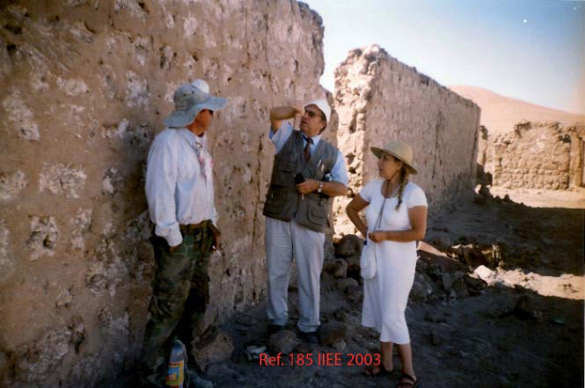
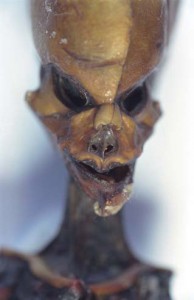
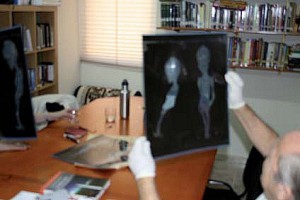
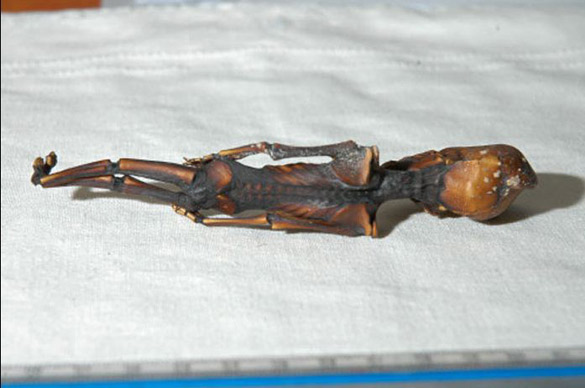
No comments:
Post a Comment